Incheon International Airport
Incheon International Airport (IIA) (Korean: 인천국제공항) (IATA: ICN, ICAO: RKSI) (sometimes referred to as Seoul–Incheon International Airport) is the largest airport in South Korea, the primary airport serving the Seoul Capital Area, and one of the largest and busiest airports in the region. As of 2020, it has been rated as the world's fourth best and one of the cleanest airports by Skytrax along with Singapore Changi Airport and Tokyo Haneda Airport.[3][4][5]
Incheon International Airport 인천국제공항 | |||||||||||||||||||||||
|---|---|---|---|---|---|---|---|---|---|---|---|---|---|---|---|---|---|---|---|---|---|---|---|
 Aerial view of Incheon International Airport | |||||||||||||||||||||||
| Summary | |||||||||||||||||||||||
| Airport type | Public | ||||||||||||||||||||||
| Owner | Ministry of Land, Infrastructure and Transport | ||||||||||||||||||||||
| Operator | Incheon International Airport Corporation | ||||||||||||||||||||||
| Serves | Seoul Capital Area | ||||||||||||||||||||||
| Location | Jung District, Incheon, South Korea | ||||||||||||||||||||||
| Opened | 29 March 2001 | ||||||||||||||||||||||
| Hub for | |||||||||||||||||||||||
| Focus city for | |||||||||||||||||||||||
| Elevation AMSL | 7 m / 23 ft | ||||||||||||||||||||||
| Coordinates | 37°27′48″N 126°26′24″E | ||||||||||||||||||||||
| Website | www.airport.kr | ||||||||||||||||||||||
| Maps | |||||||||||||||||||||||
 Incheon in South Korea | |||||||||||||||||||||||
| Runways | |||||||||||||||||||||||
| |||||||||||||||||||||||
| Helipads | |||||||||||||||||||||||
| |||||||||||||||||||||||
| Statistics (2019) | |||||||||||||||||||||||
| |||||||||||||||||||||||
| Incheon International Airport | |
| Hangul | |
|---|---|
| Hanja | |
| Revised Romanization | Incheon gukje gonghang |
| McCune–Reischauer | Inch'ŏn kukche konghang |
The airport opened on 29 March 2001 to replace the older Gimpo International Airport, which now serves mostly domestic destinations and shuttle flights to several East Asian metropolitan areas including Beijing, Hong Kong, Osaka, Shanghai, Singapore, Taipei and Tokyo.
Incheon International Airport is located west of Incheon's city center, on an artificially created piece of land between Yeongjong and Yongyu Islands. The two islands were originally separated by shallow sea. That area between the two islands was reclaimed for the construction project, effectively connecting the once separate Yeongjong and Yongyu islands. The reclaimed area as well as the two islands are all part of Jung-gu, an administrative district of Incheon. It has 111 boarding gates altogether, with 44 in Terminal 1, 30 in Concourse A (connected to Terminal 1), and 37 in Terminal 2.

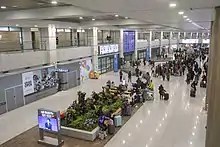
History
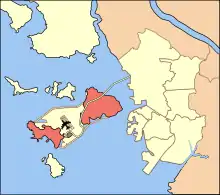

After the 1988 Summer Olympics, international air traffic to Korea increased. In the 1990s, it became apparent that Gimpo International Airport could not cope with the increase in air traffic. To reduce the load on Gimpo International Airport, the government decided to build a new international airport.
The new airport was originally planned to be located in Cheongju, 124 km southeast from Seoul, but due to its distance, it was opposed by Seoul and Gyeonggi citizens. Hwaseong was the other choice, but it was also rejected due to similar reasons. Finally the area chosen was Incheon.
In November 1992, the construction of the Incheon airport began on reclaimed land between Yeongjong Island and Youngyu Island, and took eight years to finish, with an additional six months for testing. Completion was initially scheduled for 1997 but delayed due to the economic crisis.[6] The airport was officially opened on 21 March 2001.
On 15 November 2006, the Airbus A380 landed at the airport as part of the first leg of its certification trip.[7] Tests on the runways, taxiways, and ramps showed that the airport could handle the aircraft.
To further upgrade service, Incheon and major Korean logistics firm Hanjin Group (parent company of Korean Air) agreed on 10 January 2008 to build Yeongjong Medical Centre, which was completed in 2012. This hospital serves nearby residents and some of the 30,000 medical tourists who come to Korea annually.[8]
Statistics
Located 48 km (30 mi) west of Seoul, the capital and the largest city of South Korea, Incheon International Airport is the main hub for Korean Air, Asiana Airlines, Jeju Air, and Polar Air Cargo. The airport serves as a hub for international civilian air transportation and cargo traffic in East Asia. In 2016, the Incheon International Airport was the fifth busiest airport in the world and third in Asia by cargo traffic, and 19th in the world and eighth in Asia by passenger traffic. In 2016, the airport served a total of 57,849,814 passengers.
The airport opened for business in early 2001 to replace the older Gimpo International Airport, which now serves mostly domestic destinations plus shuttle flights to alternate airports in Osaka, Shanghai, Taipei and Tokyo.
Construction phases
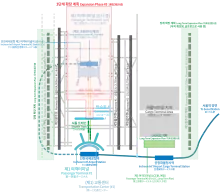
The airport was originally planned to be built in three phases, incrementally increasing airport capacity as the demand grew. This was changed, however, to four phases after the airport was opened.
Phase 1
In Phase 1, the airport had a capacity of 30 million passengers annually, and a cargo capacity of 1.7 million metric tonnes annually. In this phase, a passenger terminal with a floor space of 496,000 square metres (5,340,000 sq ft), two parallel runways, a control tower, an administrative building, a transportation centre (the Integrated Transportation Centre, designed by Terry Farrell and Partners and Samoo Architects & Engineers), and integrated operations centre, three cargo terminals, international business centre, and a government office building were constructed.
Phase 2
Phase 2 construction began in 2002, and was originally expected to be completed in December 2008. However, in an attempt to have the airport ready for the 2008 Beijing Olympics, which took place in August 2008, the schedule was modified, and Phase 2 construction was completed on 20 June 2008. During this construction phase, a third parallel 4,000-metre-long (13,000 ft) runway and a 13-hectare cargo terminal area were added. A 16.5-hectare concourse connected to the main passenger building via two parallel 870-metre-long (2,850 ft) underground passageways was added, with a Mitsubishi Crystal Mover shuttle train APM shuttling passengers between the concourse and the main terminal.[9]
Many long-distance foreign carriers were moved to the new concourse, with Korean Air and Asiana Airlines continuing to use the existing terminal.
Phase 3
The South Korean government invested ₩4 trillion until 2017 to expand Incheon International Airport. The second passenger terminal was constructed in the northern field of the airport, and its existing cargo terminal and other infrastructures were expanded. The terminals are connected to each other by the underground "Starline" train. Also, a Landside Connecting system (Bus shuttle) is used for airport employees and departing passengers who don't come to the right terminal. After completion, Incheon International Airport is able to handle 62 million passengers and 5.8 million tons of cargo a year, up from the previous capacity of 44 million passengers and 4.5 million tons. Construction began in 2011 and was completed in 2017. The terminal opened on 18 January 2018. Incheon's expansion also include adding more aprons to park planes and extending a railway line to the city center of Seoul about 70 kilometres (43 mi) away from the airport. The airport also signed an agreement to build a resort called "Inspire" which includes 6-star hotels, theme parks, and a casino.[10]
Phase 4
Estimated to be completed in 2023, this is the final and the ultimate construction stage. Upon completion, the airport will have two passenger terminals, four satellite concourses, 128 gates, and five parallel runways (one exclusively for cargo flights).[11] It will be able to handle 100 million passengers and 7 million metric tonnes of cargo annually, with further possible expansions. The airport is projected to be transformed into one of the ten busiest airports in the world by 2023.
Terminals

Terminal 1
Terminal 1 (measuring 496,000 square meters) is the largest airport terminal in area in South Korea. Terminal 1 was designed by Curtis W. Fentress, FAIA, RIBA of Fentress Architects. It is 1,060 metres (3,480 ft) long, 149 metres (489 ft) wide, and 33 metres (108 ft) high. Its construction cost was 1.3816 trillion South Korean Won. The terminal has 44 boarding ports (all of which can accommodate the Airbus A380), 50 customs inspection ports, 2 biological quarantine counters, 6 stationary and 14 portable passenger quarantine counters, 120 arrival passport inspection counters, 8 arrival security ports, 28 departure security ports, 252 check in counters, and 120 departure passport inspection counters. In 2015, an automatic check-in counter lane was introduced, where people traveling via Korean Air, Asiana Airlines and China Southern Airlines can use. Instead of having airport staff at the counter, there is a machine where travelers input their flight information, scan their passports, receive their flight tickets and lastly, load the luggage onto the conveyor. This system was planned to be introduced in Terminal 2, but in May 2015 Incheon Airport used one of the counter islands for the unmanned luggage handling system.[12]
Concourse
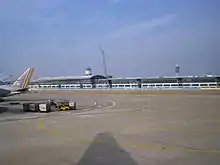
The passenger concourse was completed at the end of May 2008. It is connected to Terminal 1 by two parallel 870-metre-long (2,850 ft) underground passageways equipped with IATs (Intra Airport Transit). It has 30 gates and six lounges[13] (Asiana Airlines/Star Alliance, Singapore Airlines/Star Alliance, Japan Airlines/Oneworld, Korean Air/SkyTeam, and China Eastern Airlines/SkyTeam).
Terminal 2

A new passenger terminal opened on 18 January 2018, and Korean Air, KLM, Delta Air Lines, and Air France flights were relocated from Terminal 1 to Terminal 2. Other SkyTeam members such as Aeromexico, Alitalia, China Airlines, Garuda Indonesia, XiamenAir, Czech Airlines and Aeroflot started serving the Terminal 2 on 28 October 2018. Rest of the SkyTeam members, such as Vietnam Airlines, China Eastern Airlines and Shanghai Airlines, will be relocated to Terminal 2 after the Phase 4 construction work is complete.[14]
Airlines and destinations
Passenger
Cargo
Accolades
Incheon International airport has been the recipient of a number of awards since its opening, including:
- Best Airport Worldwide at the first Airport Service Quality Awards in 2007.[71]
- Won the GT Tested Award for Best Airport in the World in January 2007.[72]
- Named by Global Traveler (GT) as the Best Airport in the World for the second straight year in January 2008.[8]
- Named World's Best Airport for 2009, in the World Airport Survey results published by Skytrax.
- In 2012 it was ranked the best airport in the world by Skytrax.[73]
| Year | Award | Category | Results | Ref |
|---|---|---|---|---|
| 2009 | Airport Service Quality Awards by Airports Council International | Best Airport Worldwide | Won | [74] |
| Best Airport in Asia-Pacific | Won | |||
| Best Airport by Size (25–40 million passengers) | Won | |||
| 2010 | Best Airport Worldwide | Won | [75] | |
| 2011 | Won | [76] |
Accidents and incidents
On 16 June 2011, Airbus A321-200 Flight 324 operated by Asiana Airlines HL7763 between Chengdu Shuangliu International Airport, China and Incheon International Airport was fired upon by two soldiers of the Republic of Korea Marine Corps as it came in to land at Incheon. A total of 99 rounds were discharged at the aircraft, which was out of range and made a safe landing without sustaining any damage. The soldiers had misidentified the aircraft as belonging to the North Korean military, and were acting on orders that gave them permission to engage without reference to senior officers, following the Bombardment of Yeonpyeong in November 2010.[77]
Ground transport

Bus
Airport shuttle buses transport passengers between Terminal 1 and Terminal 2. Buses are free, arrive every 5 to 8 minutes, take approximately 20 minutes travel time, and stop at the Hyatt Hotel or airport fire station in route, depending on direction.
Airport buses are called limousine buses. Standard limousine buses travel to Gimpo Airport & Songjeong station.
Intercity buses connect with other towns and cities in Korea.
The Korea City Air Terminal in Gangnam is linked with the airport through limousine buses.[78]

Rail
The Airport Railroad Express (AREX and styled as A'REX) has a station located in the Transport Centre adjacent to the Terminal 1 building and is in the basement of Terminal 2. It provides service to Gimpo International Airport and Seoul. Many of the stations along the line provide connections to Incheon Subway, Seoul Metropolitan Subway, and Incheon Airport Maglev.
For departing passengers, Seoul Station City Airport Terminal has check-in and immigration facilities before arrival at the airport.
The Korea Train eXpress (KTX) operated at the same station as AREX but used a different platform. It operated 20 times per day from the airport; twelve times on the Gyeonbu Line, twice on the Gyeonjeon Line, four times on the Honam Line, and twice on the Jeolla Line. The service started in 2014 but was suspended in March 2018 due to low ridership.[79] The suspension became permanent in September 2018 as the line was officially closed.[80][81]
The Incheon Airport Maglev opened in February 2016. The first phase is 6.1 km long, spread over six stations, taking riders from the airport toward the south-west of the island where a water park is located. Phase 2 will be 9.7 km long, extending the line to the north-west of the island. Phase 3 will add 37.4 km, transforming the line into a circle.[82][83][84]

Ferry
A ferry service connects Yeongjong-do to the mainland. However, the dock is located a considerable distance from the airport. An alternative means of transport must be sought upon arriving at the island to be able to get to the airport.[85]
Car
The airport provides a short term parking lot for 4,000 cars and a long-term parking lot for 6,000 cars. Shuttle services connect the long-term parking lot to the passenger terminal and the cargo terminal. Car rental is located near the long-term parking lot. A link to the mainland is provided by the toll Yeongjong Bridge and an expressway; A second expressway on the Incheon Bridge also connects the island but to central Incheon.
Traffic and statistics
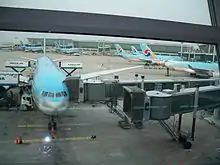

In 2017, the airport was the world's fourth busiest airport by cargo traffic and third in Asia,[86] and the world's 19th busiest airport by passenger traffic and ninth in Asia.[87] In 2019, the airport served a total of 70,857,908 passengers.
Top destinations
Domestic destinations are shown below:
| Rank | Airport | Aircraft
Operations |
Passengers | |
|---|---|---|---|---|
| 1 | Busan-Gimhae | 4,122 | 462,504 | |
| 2 | Daegu | 1,453 | 92,335 | |
| 3 | Jeju | 164 | 28,300 | |
| 4 | Muan | 1 | 144 | |
| 5 | Ulsan | 2 | 142 | |
| 6 | Yangyang | 7 | 138 | |
| Source: KAC Airport statics | ||||
Annual traffic
| Years | Aircraft
Operations |
Passengers | Cargo | |
|---|---|---|---|---|
| 2001 | 86,807 | 14,542,290 | 1,186,015 | |
| 2002 | 126,094 | 20,924,171 | 1,705,928 | |
| 2003 | 130,185 | 19,789,874 | 1,843,055 | |
| 2004 | 149,776 | 24,084,072 | 2,133,444 | |
| 2005 | 160,843 | 26,051,466 | 2,150,139 | |
| 2006 | 182,007 | 28,191,116 | 2,336,571 | |
| 2007 | 211,404 | 31,227,897 | 2,555,580 | |
| 2008 | 211,102 | 29,973,522 | 2,423,717 | |
| 2009 | 198,918 | 28,549,770 | 2,313,002 | |
| 2010 | 214,835 | 33,478,925 | 2,684,499 | |
| 2011 | 229,580 | 35,062,366 | 2,539,222 | |
| 2012 | 254,037 | 38,970,864 | 2,456,724 | |
| 2013 | 271,224 | 41,482,828 | 2,464,385 | |
| 2014 | 290,043 | 45,512,099 | 2,557,681 | |
| 2015 | 305,446 | 49,281,220 | 2,595,677 | |
| 2016 | 339,673 | 57,765,397 | 2,714,341 | |
| 2017 | 360,295 | 62,082,032 | 2,921,691 | |
| 2018 | 387,497 | 68,259,763 | 2,952,123 | |
| 2019 | 404,104 | 71,169,722 | 2,764,369 | |
| 2020 | 149,982 | 12,094,851 | 2,822,370 | |
| Source: IIAC Airport Statistics[2] | ||||
Top carriers
In 2018, the twelve carriers with the largest percentage of passengers flying into, out of, or through Incheon are as follows:
| Rank | Carrier | Aircraft
Operations |
Passengers | % |
|---|---|---|---|---|
| 1 | Korean Air | 94,214 | 17,755,258 | 26.01% |
| 2 | Asiana Airlines | 64,449 | 12,311,259 | 18.04% |
| 3 | Jeju Air | 32,370 | 5,521,533 | 8.09% |
| 4 | Jin Air | 21,801 | 4,357,286 | 6.38% |
| 5 | T'way Air | 15,426 | 2,537,978 | 3.72% |
| 6 | Eastar Jet | 13,990 | 2,241,671 | 3.28% |
| 7 | Air Seoul | 10,169 | 1,727,681 | 2.53% |
| 8 | China Eastern Airlines | 11,282 | 1,625,062 | 2.38% |
| 9 | China Southern Airlines | 11,678 | 1,583,939 | 2.32% |
| 10 | VietJet Air | 5,991 | 1,094,883 | 1.60% |
| 11 | Cathay Pacific | 4,412 | 1,051,652 | 1.54% |
| 12 | Air China | 6,298 | 882,438 | 1.29% |
See also
References
- "해당 월 통계자료는 익월 업무일 기준 5일 이후 공표". Archived from the original on 20 January 2019. Retrieved 20 January 2019.
- "Airport Statistics". Archived from the original on 6 March 2019. Retrieved 15 February 2017.
- "The World's Best Airports for Transit Passengers". Archived from the original on 2 May 2016. Retrieved 7 May 2016.
- "World's Best Transit Airports 2020". SKYTRAX. Archived from the original on 22 September 2020. Retrieved 15 May 2020.
- "The World's Best Airports in 2020 are announced". SKYTRAX. 11 May 2020. Archived from the original on 22 May 2020. Retrieved 15 May 2020.
- "Incheon". Archived from the original on 22 September 2020. Retrieved 22 May 2019.
- "The long journey to delivery". Archived from the original on 22 September 2020. Retrieved 22 May 2019.
- "Incheon Airport to Open New Concourse". Koreatimes.co.kr. 29 May 2008. Archived from the original on 20 August 2012. Retrieved 28 November 2010.
- "Incheon Airport to Have New Terminal by 2017". Korea Herald. 29 June 2009. Archived from the original on 13 April 2012. Retrieved 29 June 2009.
- Park, Sungsoon (September 2016). "Incheon Airport - Airport City" (PDF). Airports Council International - North America (ACI-NA). Archived from the original (PDF) on 6 October 2017.
- Future Travel Experience (21 May 2015). "Incheon Airport launches new self-service bag drop system". Future Travel Experience. Archived from the original on 22 September 2020. Retrieved 7 May 2016.
- "Lounge". Archived from the original on 6 November 2019. Retrieved 22 May 2019.
- 구정모 (22 July 2015). "인천공항, 2018년 제2여객터미널에 대한항공 배치". 연합뉴스. Archived from the original on 22 September 2020. Retrieved 7 May 2016.
- "Archived copy". Archived from the original on 22 September 2020. Retrieved 25 February 2020.CS1 maint: archived copy as title (link)
- Liu, Jim. "Air Busan adds Seoul – Tokyo service from April 2020". Routesonline. Archived from the original on 22 September 2020. Retrieved 21 February 2020.
- "Air New Zealand says kia ora to Seoul - Media releases | Air New Zealand". www.airnewzealand.co.nz. Archived from the original on 22 September 2020. Retrieved 27 March 2019.
- Ltd. 2019, UBM (UK). "Air New Zealand resumes Seoul service from Nov 2019". Routesonline. Archived from the original on 20 August 2019. Retrieved 16 April 2019.
- "Air Seoul adds Fukuoka service from late-Aug 2018". routesonline. Archived from the original on 22 September 2020. Retrieved 27 June 2018.
- "에어서울, 장자제 직항편 개설..."장자제 직항편 LCC 중 처음"" (in Korean). Financial News. 4 October 2019. Archived from the original on 22 September 2020. Retrieved 6 October 2019.
- "Archived copy". Archived from the original on 22 September 2020. Retrieved 12 November 2019.CS1 maint: archived copy as title (link)
- Liu, Jim. "Asiana Airlines W19 Phu Quoc service changes". Routesonline. Archived from the original on 22 September 2020. Retrieved 30 September 2019.
- Liu, Jim. "Bamboo Airways delays new International routes launch to August 2020". Routesonline. Archived from the original on 25 June 2020. Retrieved 25 June 2020.
- Liu, Jim. "China Eastern adds Yanji – Seoul service from late-Oct 2019". Routesonline. Archived from the original on 22 September 2020. Retrieved 2 October 2019.
- Liu, Jim. "Delta NW20 Intercontinental operation changes as of 26SEP20". Airlineroute. Retrieved 26 September 2020.
- "Eastar Jet announcement". Eastarjet.com. Retrieved 28 October 2019.
- Liu, Jim. "EastarJet adds Seoul – Kaohsiung service from late-Oct 2019". Routesonline. Archived from the original on 4 October 2019. Retrieved 3 October 2019.
- "Eastar Jet adds Macau service from Nov 2019". routesonline. Archived from the original on 16 October 2019. Retrieved 16 October 2019.
- "EastarJet expands Vietnam network in Feb 2019". routesonline. Archived from the original on 22 September 2020. Retrieved 18 January 2019.
- "Yonhapnews Agency - Mobile". 17 October 2018. Archived from the original on 25 October 2018. Retrieved 25 October 2018.
- "이스타항공, 인천~상하이 정기편 첫 운항…국적 LCC 최초" (in Korean). 14 July 2019. Archived from the original on 22 September 2020. Retrieved 14 July 2019.
- "EastarJet adds new routes to China in Sep 2019". Routesonline. Archived from the original on 22 September 2020. Retrieved 28 October 2019.
- "Notice".
- Jeju Air adds Chiang Mai service in W17 Archived 22 September 2020 at the Wayback Machine Routesonline. 21 December 2017.
- "Jeju Air aggressive in adding new routes to China - Pulse by Maeil Business News Korea". Archived from the original on 22 September 2020. Retrieved 2 September 2018.
- "Jeju Air plans 2 new routes in 1Q18". routesonline. Archived from the original on 1 December 2017. Retrieved 30 November 2017.
- "Jeju Air adds new routes to China in 3Q19". Routesonline. 14 August 2019. Archived from the original on 14 August 2019. Retrieved 14 August 2019.
- Liu, Jim. "Jeju Air 4Q19 network additions". Routesonline. Archived from the original on 22 September 2020. Retrieved 30 September 2019.
- Ltd. 2019, UBM (UK). "Jeju Air Saipan service changes from late-Nov 2018". Routesonline. Archived from the original on 22 September 2020. Retrieved 17 November 2018.
- 2018, UBM (UK) Ltd. "Jeju Air resumes Yantai service from April 2018". Archived from the original on 22 September 2020. Retrieved 20 March 2018.CS1 maint: numeric names: authors list (link)
- Ltd. 2019, UBM (UK). "JetStar extends Seoul Incheon reservations into NS20". Routesonline.
- "Jin Air expands Malaysia service in 1Q18". Routesonline. Archived from the original on 22 September 2020. Retrieved 20 October 2017.
- "Archived copy". Archived from the original on 22 September 2020. Retrieved 23 April 2020.CS1 maint: archived copy as title (link)
- "Archived copy". Archived from the original on 22 September 2020. Retrieved 23 April 2020.CS1 maint: archived copy as title (link)
- Arayata, Ma. Cristina (3 July 2019). "Korean Air to launch Incheon-Clark route in October". Philippine News Agency. Archived from the original on 11 August 2019. Retrieved 11 August 2019.
- Liu, Jim. "Korean Air schedules additional routes to China in W19". Routesonline. Archived from the original on 11 October 2019. Retrieved 4 October 2019.
- "Archived copy". Archived from the original on 22 September 2020. Retrieved 14 December 2019.CS1 maint: archived copy as title (link)
- Liu, Jim. "Korean Air adds seasonal Siem Reap service from late-Dec 2019". Routesonline. Archived from the original on 17 December 2019. Retrieved 17 December 2019.
- Korean Air increases Urumqi service in S18 Archived 22 September 2020 at the Wayback Machine Routesonline. 17 April 2018.
- "South Korea to resume Seoul-Tbilisi charter flights in May". 4 April 2019. Archived from the original on 10 May 2019. Retrieved 10 May 2019.
- "Archived copy". Archived from the original on 22 September 2020. Retrieved 25 May 2019.CS1 maint: archived copy as title (link)
- "미얀마국제항공(8M) 12월 4일 인천- 양곤 취항으로 편리해지는 미얀마 하늘길". www.ttlnews.com. Archived from the original on 29 September 2019. Retrieved 29 September 2019.
- Liu, Jim (25 September 2019). "Spring Airlines 4Q19 International network additions". Routesonline. Archived from the original on 25 September 2019. Retrieved 25 September 2019.
- "SriLankan SriLankan Airlines adds Seoul service in W20". Routesonline. 6 October 2020.
- Liu, Jim. "T'Way Air adds Seoul – Shenyang service from late-Dec 2019". Routesonline. Archived from the original on 22 September 2020. Retrieved 19 November 2019.
- Liu, Jim. "T'Way Air adds Seoul – Wuhan service from late-Jan 2020". Routesonline. Archived from the original on 16 January 2020. Retrieved 16 January 2020.
- Liu, Jim. "T'Way Air adds Seoul Incheon – Hong Kong in 3Q19". Routesonline. Archived from the original on 3 July 2019. Retrieved 3 July 2019.
- Ltd. 2019, UBM (UK). "T'Way Air adds Seoul – Kagoshima service from April 2019". Routesonline. Archived from the original on 22 September 2020. Retrieved 17 March 2019.
- Liu, Jim. "United extends International / Guam / Micronesia Island Hopper interim schedule to Sep 2020". Airlineroute. Archived from the original on 22 September 2020. Retrieved 5 July 2020.
- Liu, Jim. "VietJet Air adds international routes from Can Tho in Jan 2020". Routesonline. Archived from the original on 22 September 2020. Retrieved 2 December 2019.
- "Zipair Tokyo on track for 2020 launch". Routesonline. Archived from the original on 12 July 2019. Retrieved 28 October 2019.
- "Polar Air Cargo 997". Archived from the original on 22 September 2020. Retrieved 7 January 2018.
- "DHL opera settimanalmente tra Milano Malpensa e Seoul" [DHL begins direct weekly service between Milan Malpensa and Seoul]. italiavola.com (in Italian). 15 December 2020. Retrieved 15 December 2020.
- https://ajot.com/news/ethiopian-cargo-launches-trans-pacific-cargo-flight-services-incheon-to-atlanta-via-anchorage
- "Korean Air Launches New Direct Aervice to Budapest". Korean Air (Press release). 5 February 2020. Archived from the original on 1 January 2020. Retrieved 21 February 2020./
- "New international cargo service from LCK to ICN". Korean Air Cargo (Press release). 21 August 2020. Archived from the original on 22 September 2020. Retrieved 19 September 2020.
- "Korean Air Cargo adds Columbus Rickenbacker service in Sep 2020". Routesonline. 18 September 2020. Archived from the original on 22 September 2020. Retrieved 19 September 2020.
- "Korean Air launches cargo flights to Delhi, India - Travel News - eTurboNews". 10 July 2018. Archived from the original on 22 September 2020. Retrieved 18 July 2018.
- "대한항공, 일본 기타큐슈 화물기 신규 취항" (in Korean). Korea Logistics News. 26 November 2019. Archived from the original on 4 December 2019. Retrieved 19 September 2020.
- 2018, UBM (UK) Ltd. "Turkish Cargo adds 7 destinations in Jan 2018". Archived from the original on 22 December 2017. Retrieved 22 December 2017.CS1 maint: numeric names: authors list (link)
- Archived 16 December 2007 at the Wayback Machine
- "Premium Travelers Name Incheon International Top Airport Global Traveler Readers have Chosen the Airport as the Best in the World". PR Web Website. 21 January 2007. Archived from the original on 13 April 2012. Retrieved 27 January 2006.
- "Incheon International Airport is named the World's Best Airport in 2012 by airline travelers". Worldairportawards.com. Archived from the original on 3 August 2013. Retrieved 29 July 2013.
- "ACI Airport Service Quality Awards 2009, Asia Pacific airports sweep top places in worldwide awards" Archived 12 May 2012 at the Wayback Machine Airports Council International. 16 February 2010. Retrieved 2012-04-13
- "ASQ Award for winners for 2010". Airports Council International. Archived from the original on 20 February 2012. Retrieved 13 April 2012.
- "World's best airports announced -- Asia dominates". CNN Go. 15 February 2012. Archived from the original on 9 April 2012. Retrieved 12 April 2012.
- Hradecky, Simon. "Incident: Asiana A321 near Seoul on Jun 17th 2011, aircraft under fire". The Aviation Herald. Archived from the original on 22 September 2020. Retrieved 18 June 2011.
- "Incheon Airport Bus Station". Archived from the original on 27 January 2018. Retrieved 22 March 2018.
- Medimorec, Nikola (10 June 2018). "Incheon Airport KTX Service Suspended". Kojects. Archived from the original on 22 September 2020. Retrieved 9 July 2018.
In 2014, KORAIL began to offer KTX high-speed train connections from Incheon International Airport to Seoul, Daegu, Busan and other cities in Korea. The Incheon Airport KTX service was suspended now at the end of March 2018. The main reason was that the demand was too low and ridership stayed far below necessary numbers.
- 박, 재균 (7 August 2018). "9월부터 인천공항 KTX 노선 폐지". FNToday (in Korean). Archived from the original on 22 September 2020. Retrieved 10 August 2018.
- 민, 경석 (7 August 2018). "2014년 개통한 '인천공항 KTX' 폐지". News1 (in Korean). Archived from the original on 10 August 2018. Retrieved 10 August 2018.
- Medimorec, Nikola (28 January 2012). "Maglev at Incheon International Airport to be completed this year". Kojects. Archived from the original on 8 May 2019. Retrieved 10 July 2018.
Two more stages of construction are planned for the line; stage two is a 9.7 km extension that continues from Yongyoo Station, past the planned Marine World and up to Dragon City. Though this stage was originally scheduled to be completed in time for the Asian Games, setbacks in the development of neighboring projects are still causing delays. The final stage will be significantly longer, a 37.4 km extension that continues around the outer rim of the island and loop back to the airport.
- Han, Woojin. "영종자기부상열차 2단계". 미래철도DB (in Korean). Archived from the original on 22 September 2020. Retrieved 9 July 2018.
- Song, C. H.; Park, K.S.; Kim, C. K. (10–13 October 2011). Review on Incheon International Airport & Urban MagLev Interface. The 21st International Conference on Magnetically Levitated Systems and Linear Drives. Daejeon, Korea. p. 5. Archived from the original (PDF) on 21 December 2011. Retrieved 10 July 2018.
Phase 2 expansion line is planned to link coastal area and cover 9.7 km with 5 train stations up to the international business complex II of IIA and Phase 3 or the last phase expansion line is designed to be a ring-type alignment circumnavigating Yeongjong Island around IIA, covering 37.4 km with 16 train stations.
- "Transport in Yeongjongdo & Muuido - Lonely Planet Travel Information". lonelyplanet.com. Lonely Planet. Archived from the original on 6 October 2014. Retrieved 1 October 2014.
- "Top 20 cargo airports in 2017 | Cargo Facts". cargofacts.com. Archived from the original on 22 September 2020. Retrieved 22 August 2018.
- "The world's busiest airport revealed". CNN Travel. 9 April 2018. Archived from the original on 22 September 2020. Retrieved 22 August 2018.
- "항공통계". 항공통계. Archived from the original on 10 December 2018. Retrieved 29 January 2019.
External links
| Wikimedia Commons has media related to Incheon International Airport. |
| Wikivoyage has a travel guide for Incheon International Airport. |
- Official website
- Official Site of Korea Tourism Org.: Incheon
- Airport information for RKSI at World Aero Data. Data current as of October 2006.
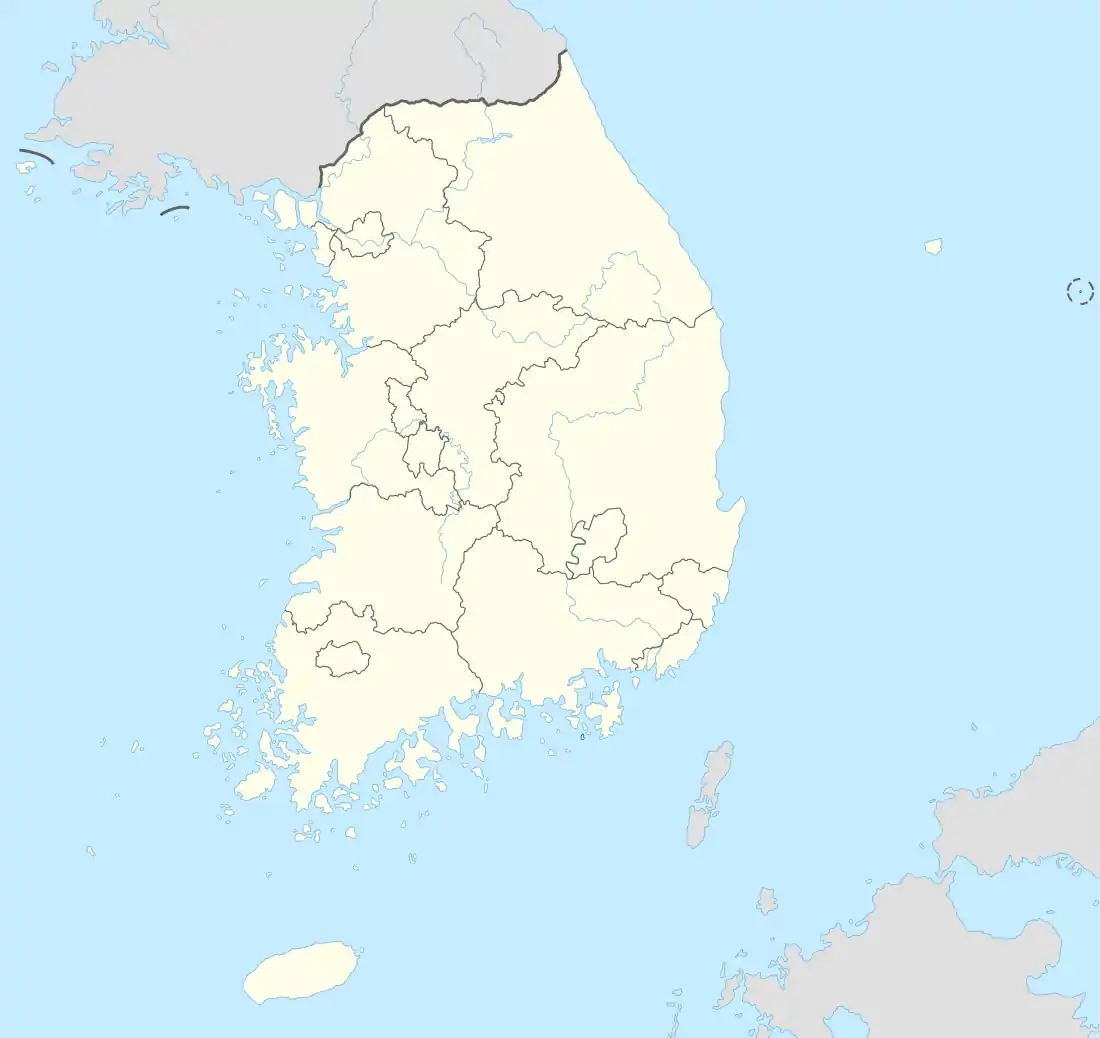
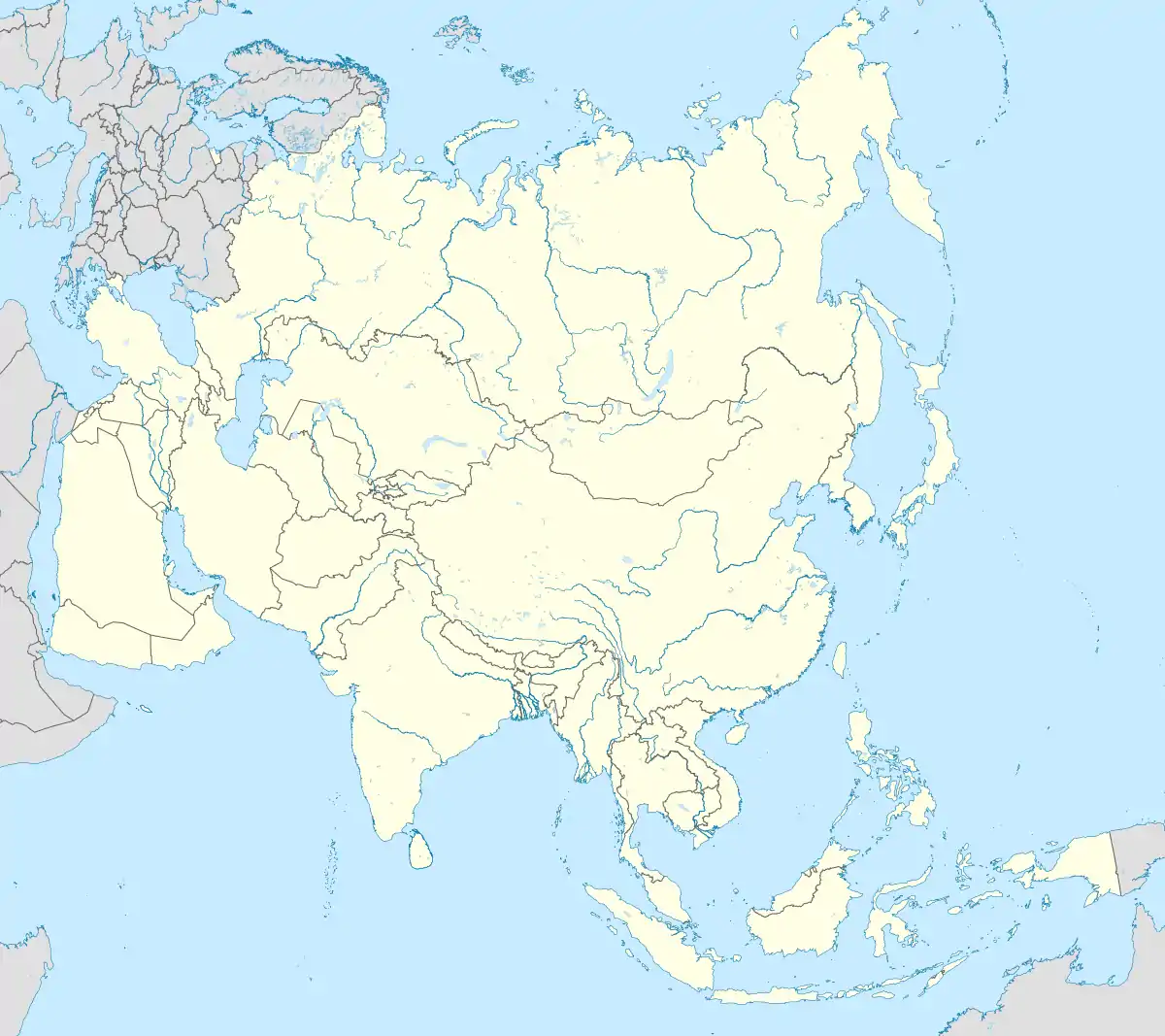
.svg.png.webp)